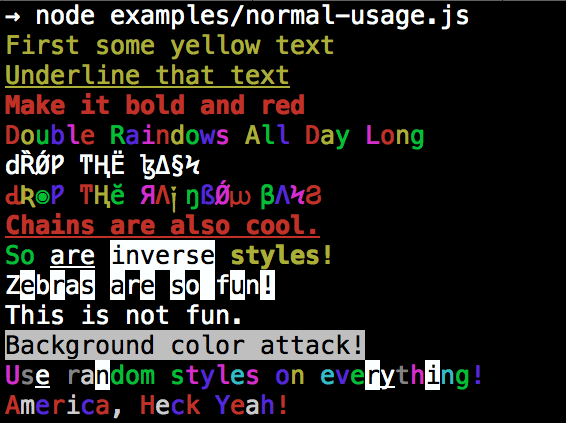|
123456789101112131415161718192021222324252627282930313233343536373839404142434445464748495051525354555657585960616263646566676869707172737475767778798081828384858687888990919293949596979899100101102103104105106107108109110111112113114115116117118119120121122123124125126127128129130131132133134135136137138139140141142143144145146147148149150151152153154155156157158159160161162163164165166167168169170171172173174175176177178 |
- # colors.js [](https://travis-ci.org/Marak/colors.js)
-
- ## get color and style in your node.js console
-
- 
-
- ## Installation
-
- npm install colors
-
- ## colors and styles!
-
- ### text colors
-
- - black
- - red
- - green
- - yellow
- - blue
- - magenta
- - cyan
- - white
- - gray
- - grey
-
- ### background colors
-
- - bgBlack
- - bgRed
- - bgGreen
- - bgYellow
- - bgBlue
- - bgMagenta
- - bgCyan
- - bgWhite
-
- ### styles
-
- - reset
- - bold
- - dim
- - italic
- - underline
- - inverse
- - hidden
- - strikethrough
-
- ### extras
-
- - rainbow
- - zebra
- - america
- - trap
- - random
-
-
- ## Usage
-
- By popular demand, `colors` now ships with two types of usages!
-
- The super nifty way
-
- ```js
- var colors = require('colors');
-
- console.log('hello'.green); // outputs green text
- console.log('i like cake and pies'.underline.red) // outputs red underlined text
- console.log('inverse the color'.inverse); // inverses the color
- console.log('OMG Rainbows!'.rainbow); // rainbow
- console.log('Run the trap'.trap); // Drops the bass
-
- ```
-
- or a slightly less nifty way which doesn't extend `String.prototype`
-
- ```js
- var colors = require('colors/safe');
-
- console.log(colors.green('hello')); // outputs green text
- console.log(colors.red.underline('i like cake and pies')) // outputs red underlined text
- console.log(colors.inverse('inverse the color')); // inverses the color
- console.log(colors.rainbow('OMG Rainbows!')); // rainbow
- console.log(colors.trap('Run the trap')); // Drops the bass
-
- ```
-
- I prefer the first way. Some people seem to be afraid of extending `String.prototype` and prefer the second way.
-
- If you are writing good code you will never have an issue with the first approach. If you really don't want to touch `String.prototype`, the second usage will not touch `String` native object.
-
- ## Disabling Colors
-
- To disable colors you can pass the following arguments in the command line to your application:
-
- ```bash
- node myapp.js --no-color
- ```
-
- ## Console.log [string substitution](http://nodejs.org/docs/latest/api/console.html#console_console_log_data)
-
- ```js
- var name = 'Marak';
- console.log(colors.green('Hello %s'), name);
- // outputs -> 'Hello Marak'
- ```
-
- ## Custom themes
-
- ### Using standard API
-
- ```js
-
- var colors = require('colors');
-
- colors.setTheme({
- silly: 'rainbow',
- input: 'grey',
- verbose: 'cyan',
- prompt: 'grey',
- info: 'green',
- data: 'grey',
- help: 'cyan',
- warn: 'yellow',
- debug: 'blue',
- error: 'red'
- });
-
- // outputs red text
- console.log("this is an error".error);
-
- // outputs yellow text
- console.log("this is a warning".warn);
- ```
-
- ### Using string safe API
-
- ```js
- var colors = require('colors/safe');
-
- // set single property
- var error = colors.red;
- error('this is red');
-
- // set theme
- colors.setTheme({
- silly: 'rainbow',
- input: 'grey',
- verbose: 'cyan',
- prompt: 'grey',
- info: 'green',
- data: 'grey',
- help: 'cyan',
- warn: 'yellow',
- debug: 'blue',
- error: 'red'
- });
-
- // outputs red text
- console.log(colors.error("this is an error"));
-
- // outputs yellow text
- console.log(colors.warn("this is a warning"));
-
- ```
-
- You can also combine them:
-
- ```javascript
- var colors = require('colors');
-
- colors.setTheme({
- custom: ['red', 'underline']
- });
-
- console.log('test'.custom);
- ```
-
- *Protip: There is a secret undocumented style in `colors`. If you find the style you can summon him.*
|
